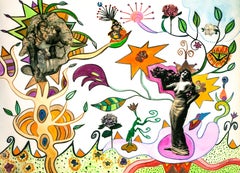Susan Bee for sale on 1stDibs
STATEMENT I have been making unique leporellos, or accordion books, since 2012 as part of my artist’s book practice. I relish the spontaneity of the gradual unfolding of the leporellos. I often start without a plan and gradually realize a theme. Each leporello has a different focus and title. I view the leporellos as long and extended drawings in a limited field. I use stickers and collage items that I have been collecting for many years. The leporellos feature collages, along with line drawings and paintings in watercolors and gouache. I also use colored pencils, crayons, and markers. I like tackling each leporello with a desire to be playful and to have fun. I really want the books to be amusing and colorful. It is a nice addition to my ongoing practice of oil painting, as well as a different direction from my many printed, published, and editioned artist’s books.
BIOGRAPHY Susan Bee is an artist living in Brooklyn. She is represented by A.I.R. Gallery in NYC, where she has been a member for 25 years and has had nine solo shows. She has had solo shows at many other venues and her work has been included in many group shows. Bee has published eighteen artist’s books. She has collaborated with: Susan Howe, Charles Bernstein, Johanna Drucker, Regis Bonvicino, Jerome McGann, Rachel Levitsky, and Jerome Rothenberg. Her latest printed book is Off-World Fairy Tales, with Johanna Drucker, Litmus Press, 2020.
Bee was the coeditor of M/E/A/N/I/N/G from 1986-2016. Her artist’s book archive and the M/E/A/N/I/N/G archive are at the Beinecke Rare Book and Manuscript Library, Yale University.
Bee has given presentations at the Whitney Museum, Reina Sofia, Brooklyn Museum, MoMA PS1, College Art Association, Queens Museum, NY Public Library, Parsons, The New School, Pratt Institute, School of Visual Arts, M.I.T., University of Pennsylvania, and at numerous other locations including in Paris, London, Amsterdam, Belgrade, Berlin, Portugal, Spain, Scotland, Israel, Cuba, New Zealand, Korea, and China.
Bee’s artwork and artist’s books are in many public and private collections including the Metropolitan Museum of Art, Douglas F. Cooley Memorial Art Gallery at Reed College, Bibliotheque Nationale de France, Getty Museum, and the Victoria & Albert Museum. Her work has been reviewed in: Art in America, The New York Times, The New Yorker, ArtNews, The Brooklyn Rail, Artcritical, ArtSlant, The Forward, Huffington Post, Art Papers, and Hyperallergic.
She has a BA from Barnard College and a MA in Art from Hunter College. She received a Guggenheim Fellowship in Fine Arts in 2014 and has had fellowships at the MacDowell Colony, Virginia Center for the Creative Arts, and Yaddo.
http://writing.upenn.edu/epc/authors/bee/
Finding the Right figurative-paintings for You
Figurative art, as opposed to abstract art, retains features from the observable world in its representational depictions of subject matter. Most commonly, figurative paintings reference and explore the human body, but they can also include landscapes, architecture, plants and animals — all portrayed with realism.
While the oldest figurative art dates back tens of thousands of years to cave wall paintings, figurative works made from observation became especially prominent in the early Renaissance. Artists like Michelangelo, Leonardo da Vinci and other Renaissance masters created naturalistic representations of their subjects.
Pablo Picasso is lauded for laying the foundation for modern figurative art in the 1920s. Although abstracted, this work held a strong connection to representing people and other subjects. Other famous figurative artists include Francis Bacon and Lucian Freud. Figurative art in the 20th century would span such diverse genres as Expressionism, Pop art and Surrealism.
Today, a number of figural artists — such as Sedrick Huckaby, Daisy Patton and Eileen Cooper — are making art that uses the human body as its subject.
Because figurative art represents subjects from the real world, natural colors are common in these paintings. A piece of figurative art can be an exciting starting point for setting a tone and creating a color palette in a room.
Browse an extensive collection of figurative paintings on 1stDibs.
